A Private Tour today, in North Norfolk. After the recent inclement weather, we were lucky (despite the date!) – the wind was light and it was mostly bright with sunny intervals, just the briefest of light drizzle as a shower passed to the south of us early afternoon, and a lovely end to the day. The forecast for today up until a couple of days ago had been for yet more wind and rain – fortunately, as is often the case, it couldn’t have been much more wrong!
After meeting up in Wells, we made our way to the edge of town. As we got out of the minibus, we could already see the Rough-legged Buzzard perched on the top of its usual bushes across the field. We got the scope straight on it, and admired its very pale head, contrasting with the dark blackish belly patch.
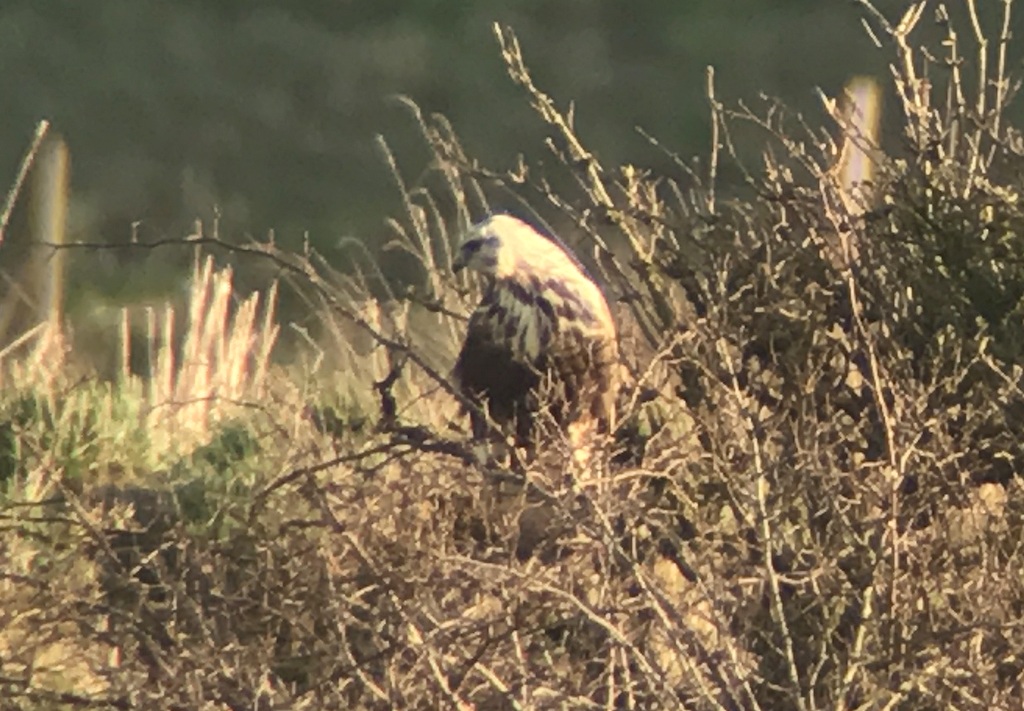
The Rough-legged Buzzard was quite active this morning, and kept taking off and flying round, flashing its white tail with black terminal bar. It never went far though, and kept returning to its perch on the bushes after a few seconds. It seemed to be mainly hunting down along the edge of the field just below where it was perched – dropping down into the grass at one point, and later stopping to hover there just a metre or so above the ground.
There were other raptors here too. We got a couple of darker Common Buzzards in the scope, very different from the Rough-legged Buzzard. Three or four different Marsh Harriers circled up, including a very dark juvenile, a pale-headed female and a grey-winged male. A Kestrel flew in and landed on the hedge.
A Barn Owl was still out, hunting along the grassy bank. It was a wet night last night, and after all the recent wind it was probably hungry and therefore out feeding during daylight hours. It would be the first of several we would see today.
There were lots of Lapwings around the flood in the ploughed field in front of us and a little group of Golden Plovers on the grass further back. A few Skylarks came up from the fields and a pair of Grey Partridge flew in and landed on the verge at the front of the nearest one.
Moving on, we stopped again at Holkham. A quick check of a field by the road revealed a Mistle Thrush feeding in amongst all the Egyptian Geese. A little further on, as we pulled up overlooking the grazing marshes, all the geese were in the air – we could see a couple of people walking around out in the middle. They gradually started to settle again, with mostly Greylags on the grass at first, although we picked out a more distant group of Barnacle Geese too. Most of the Pink-footed Geese seemed to disappear off over the park.
We could hear the distinctive yelping calls of White-fronted Geese and a couple of largish flocks of 30-60 flew back in but seemed reluctant to land again. Some came down behind the trees but eventually a small number dropped down onto the grazing marshes in view. We got three in the scope, noting their black belly bars and white surround to their pink bills.
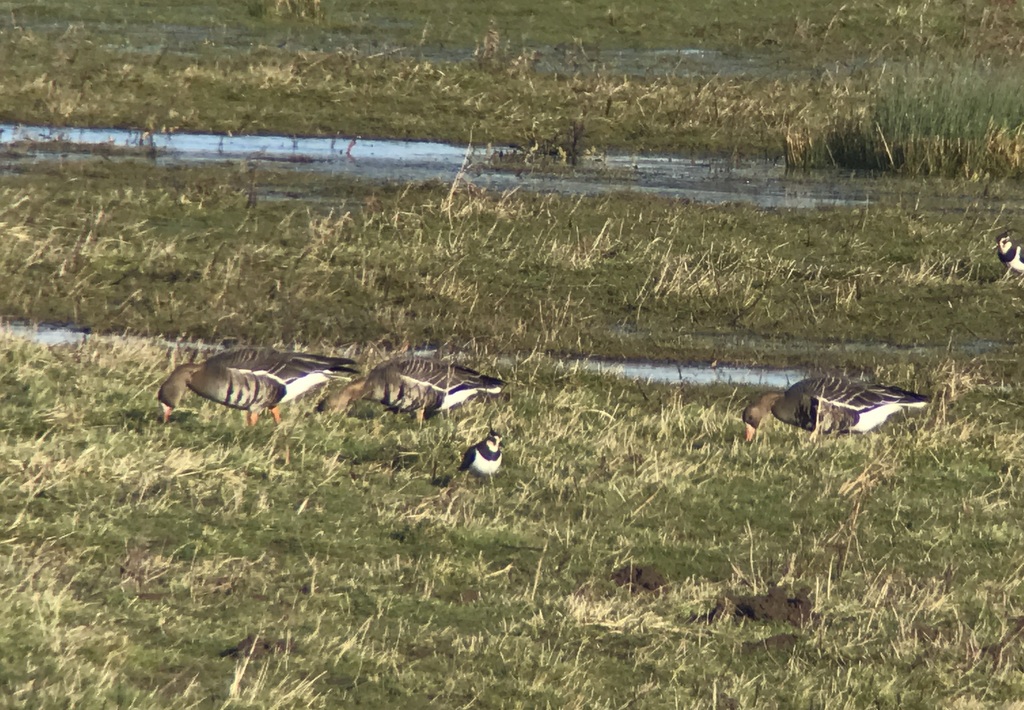
There were lots of Lapwing and Curlew out on the grazing marshes too, and scanning one of the larger pools we found a small group of roosting Avocet, in with the Shoveler and Teal. More Avocet have been returning over the last week or so, having spent the winter further south. Spring is in the air!
A large white shape out on the grazing marshes was a Great White Egret. Through the scope, we could see its long, dagger-shaped, yellow bill. A second Great White Egret flew out from behind the trees and landed beyond the reeds at the back. A smaller white shape appeared in a field of taller grass and clumps of rushes – a Cattle Egret. Looking more carefully, we realised there were actually six Cattle Egrets there, as more flew up from further over and came in to join the first. We watched them actively running around between the clumps, catching frogs.
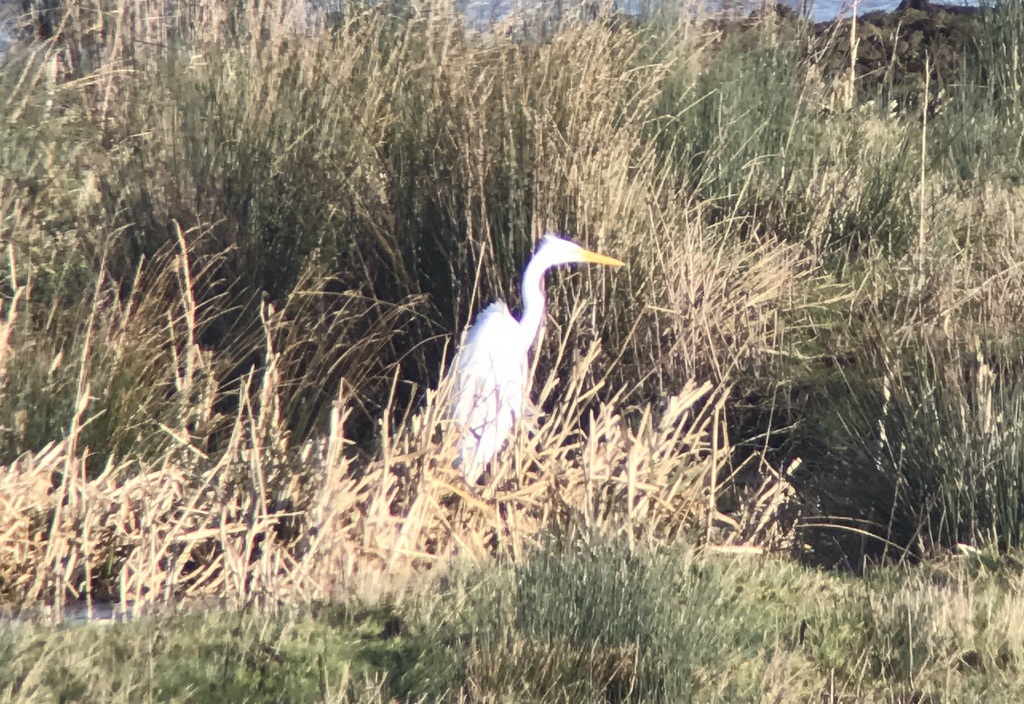
News had come through now that the Eastern Yellow Wagtail had been seen again this morning over at Sedgeford, so we set off inland to try to see it. A Red Kite was hanging in the air over the road as we made our way there. As we pulled up on the verge just north of the village, we looked over to the muck heap in the edge of the field alongside to see three wagtails fly up and land on the top. In with the Pied Wagtails was the Eastern Yellow Wagtail.
We got out quietly and were watching the Eastern Yellow Wagtail as it started to feed on the side of the heap, but a lorry came thundering down the road and the wagtails all took off. We heard the Eastern Yellow Wagtail call several times, a raspy, grating call, very different from the typical call of ‘our’ Western Yellow Wagtail, as it flew over the road and out into the field the other side.
We crossed the road and could see the Eastern Yellow Wagtail out on the bare ground with the Pied Wagtails and several Meadow Pipits. Then something spooked them again, and the Eastern Yellow Wagtail flew up and disappeared. There were lots of other birds here – several Fieldfares feeding out in the field and a small covey of Red-legged Partridges walking down along the edge.
Several Yellowhammers were in the hedges and dropping down to the ground in the lane, including some very smart yellow-headed males. A large flock of Chaffinches was feeding along the edge of the field and in with them we could see 4-5 Bramblings. They have been in short supply this winter, so it was nice to catch up with some today.
We set off down the lane to see if the Eastern Yellow Wagtail was on the other muck heap further along, with all the Chaffinches, Bramblings and Yellowhammers flying down along the hedges either side, ahead of us. A large flock of Linnets was swirling round further along, but there was no sign of the wagtail, so we walked back.
When we got back to the first muck heap, by the road, the Eastern Yellow Wagtail was back. We had a great view of it now, as it fed on the sides of the heap and around the puddles at the base in the sunshine. It is a striking bird, with yellow underparts and a grey head with bold white supercilium. Having been found here originally just before Christmas, it looks like it may stay here through the winter now.

We were heading for Titchwell next, but we called in at Thornham Harbour on our way. The water level in the harbour channel was still quite high and there were just a couple of Common Redshanks and a single Black-tailed Godwit here at the moment, with a flock of Brent Geese further out in the harbour. Three Rock Pipits flew in and landed in the vegetation just beyond the channel. There was no sign of the Twite, so we didn’t stop – we had plenty of other things we wanted to try to fit in this afternoon.
Round at Titchwell, there were loads of Goldfinches twittering in the tops of the trees in the car park. We decided to have a quick whisk round the reserve before a late lunch. We were told there was no sign of the Woodcock on Fen Trail, but we had a quick look on our way round anyway. We couldn’t find it now either, and there was no sign of any Water Rails in the ditches by the main path, so we set out onto the reserve. There were a few Common Pochard with the Gadwall on the reedbed pool and we heard a quick burst of Bearded Tits calling, but couldn’t see them.
There were not so many waders on the Freshmarsh today – a small group of Avocets asleep, and a Black-tailed Godwit asleep with them, and several pairs of Avocets busy feeding in the shallow water. There were lots of Teal around the edges of the water and several Shoveler busy shovelling, the drakes of both looking very smart now in their breeding plumage.
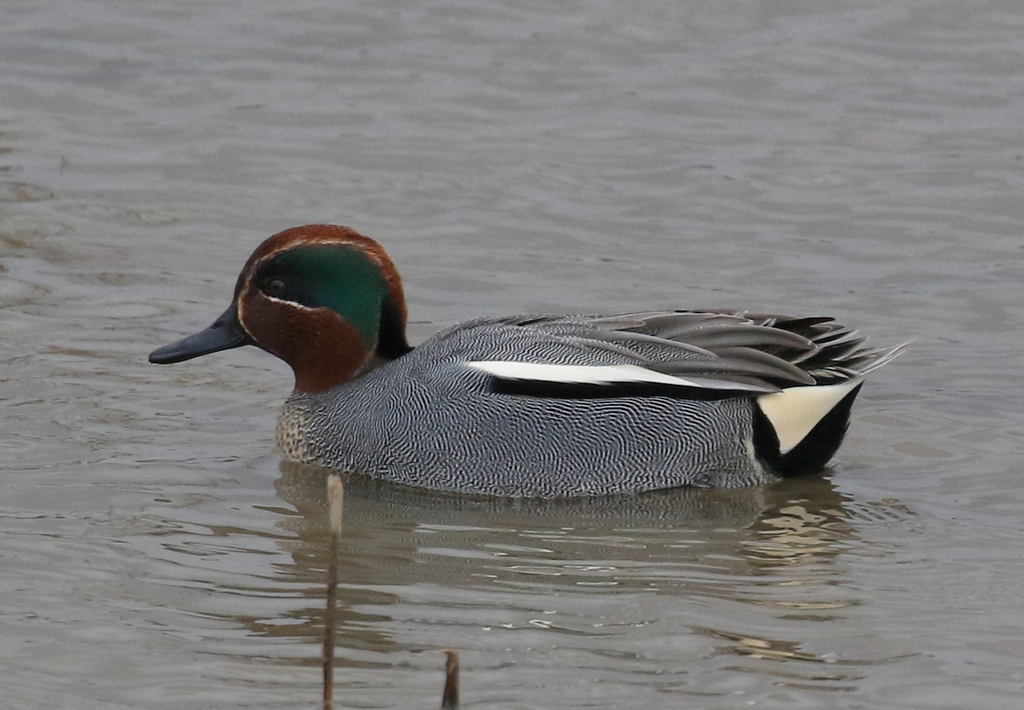
We were hoping to find a Water Pipit here, but at first all we could find were Rock Pipits. First one flew towards us from the direction of the reedbed, but carried on over our heads and dropped down on to the saltmarsh the other side of the bank. Then we looked across to see several small birds land on the pile of bricks in front of Parrinder Hide – but through the scope, we could see they were three Rock Pipits accompanied by a Reed Bunting, the former presumably having come in for a freshwater bath.
Scanning the cut reeds along the edge of the bank beyond the hide through the scope, we could see a small bird in the vegetation. At last, a Water Pipit! It was hard to see at this range, so we walked quickly round to Parrinder Hide, but by the time we got round there needless to say it had disappeared again. Thankfully, after a bit of scanning, we found it on Avocet Island, on the ground behind the fence.
The Water Pipit had obviously had a bathe, as it was now busy preening. The Rock Pipits had been bathing too, and a couple of them flew up and landed on the fence, in the same view. The Water Pipit was clearly much cleaner, white below, with finer black streaks, and less swarthy above, greyer headed with a clear white supercilium. The Water Pipit finished preening and flew up onto the fence too, before flying back over to the bank out to the east of the hide. We watched it back down in the cut reeds before it walked further back out of view.
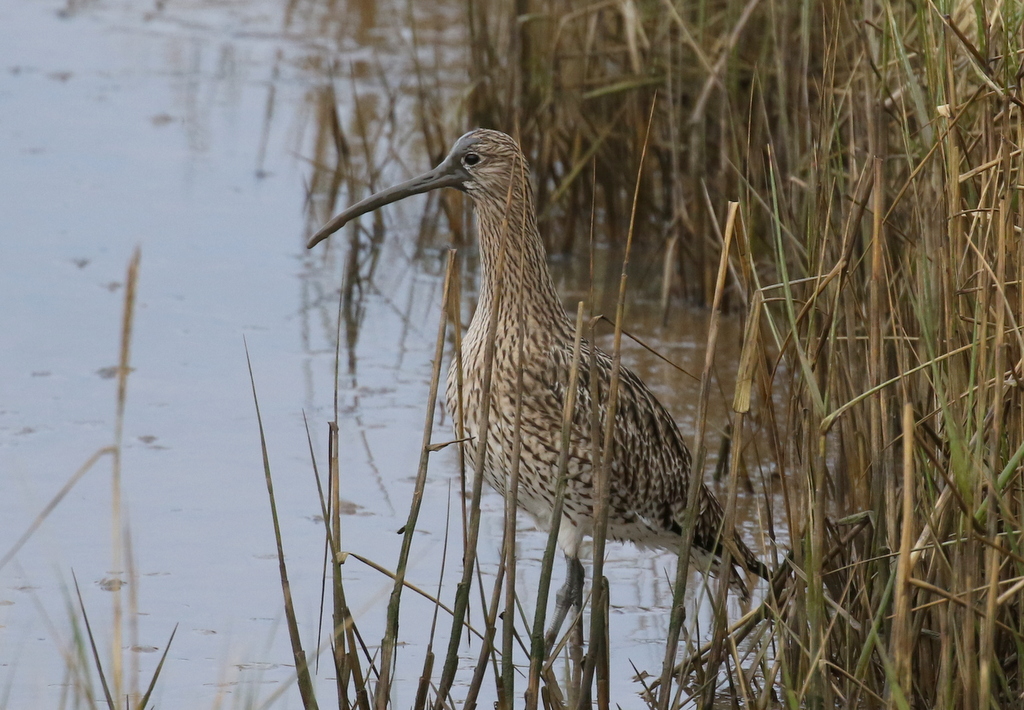
Someone in the hide asked whether we had seen a Knot and was quite insistent there should be one on the Freshmarsh because it was on the recent sightings board! We pointed out that they only drop in here occasionally and are normally to be found on the saltmarsh or out on the beach. We popped into the other side of Parrinder Hide and just about the first bird we saw on the saltmarsh out on Volunteer Marsh was a Knot! It was with a Grey Plover nearby, and feeding down at the front was a muddy-faced Curlew. When we walked back out, we could see a small flock of Knot had now dropped into the Freshmarsh too, for a quick bathe.
Out at the Tidal Pool, one of the first birds we found was a Red-breasted Merganser. It was diving in the shallow water and seemed to be pulling at something or probing around one of the smaller islands. They are more commonly seen out on the sea than on here. A single pair of Pintail were fast asleep towards the back and a Little Grebe was dozing below the vegetation along the edge. A Water Rail swam out from the edge and we watched as it make its way straight across the deeper water in the middle. It came out and ran nervously across one of the low muddy islands before swimming across the last strip of water to the safety of the vegetated bank the other side.
There were not so many waders on here now – with the tide out, they were mostly feeding out on the beach. There were a few Common Redshanks, and it was nice to compare a single Bar-tailed Godwit on one of the small islands with a Black-tailed Godwit feeding in the water down at the front.
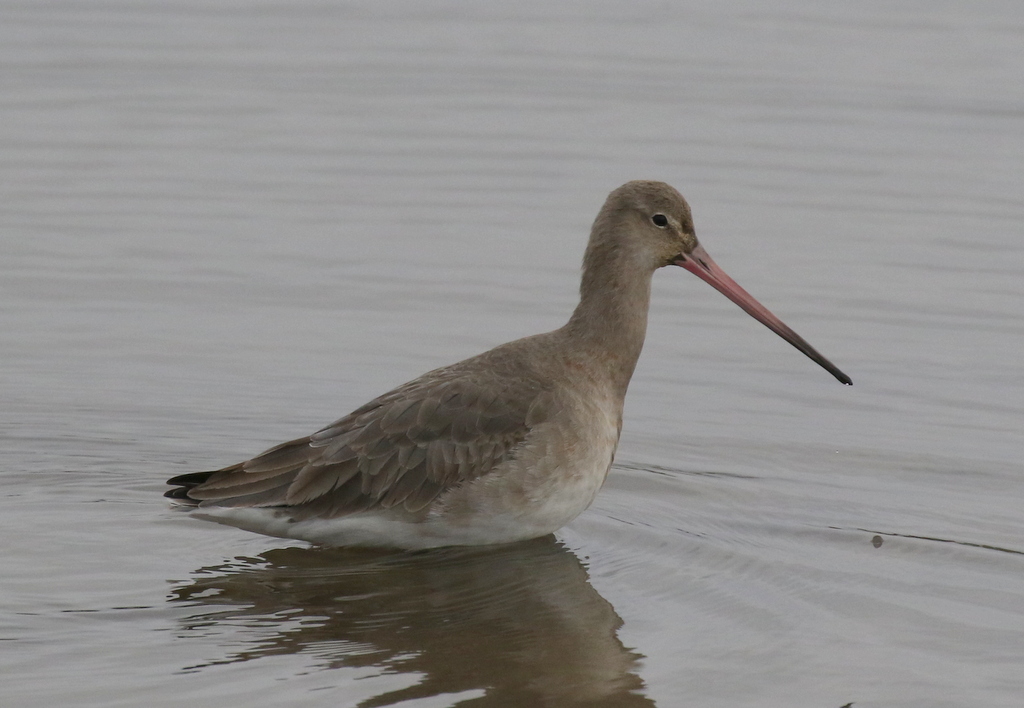
There were a lot more Bar-tailed Godwits feeding out on the beach. A few Turnstones were feeding on the top of the mussel beds and several Dunlin were running around on the sand nearby. Scanning the sea, we could see a few Great Crested Grebes offshore. A couple of Eider and a small group of Goldeneye were rather distant today. We couldn’t immediately see much else out there today, so we walked back for lunch at the Visitor Centre. A Coal Tit coming into the feeders was an addition to the day’s list.
After lunch, we made our way back east along the coast road. On the way, we stopped to look at a small group of Pink-footed Geese in a field beside the road, the first we had seen on the ground today. We stopped again briefly at Holkham, overlooking the grazing marshes where we had stopped earlier. We were immediately rewarded with three Spoonbills on a small pool, just what we were hoping to find here. We watched them feeding, walking round quickly, sweeping their bills from side to side through the shallow water. The Spoonbills are starting to return already, ahead of the breeding season, having spent the winter down on the south coast.
A Barn Owl appeared over the grassy field next to us. We watched it flying round hunting, turning into the wind and doing a transect across over the grass, before flying back to the near edge and turning into the wind to do it again. It landed on a post for a rest, where we had a good look at it in the scope. Then when it started hunting again, we saw it drop sharply down into the tall grass. We could just see it seemed to be ‘mantling’ over something, with its wings open, and sure enough it came back up with vole in its talons, landing on a post again briefly before flying off with it over the hedge. Looking out across the grazing marsh, we could see a second Barn Owl off in the distance.
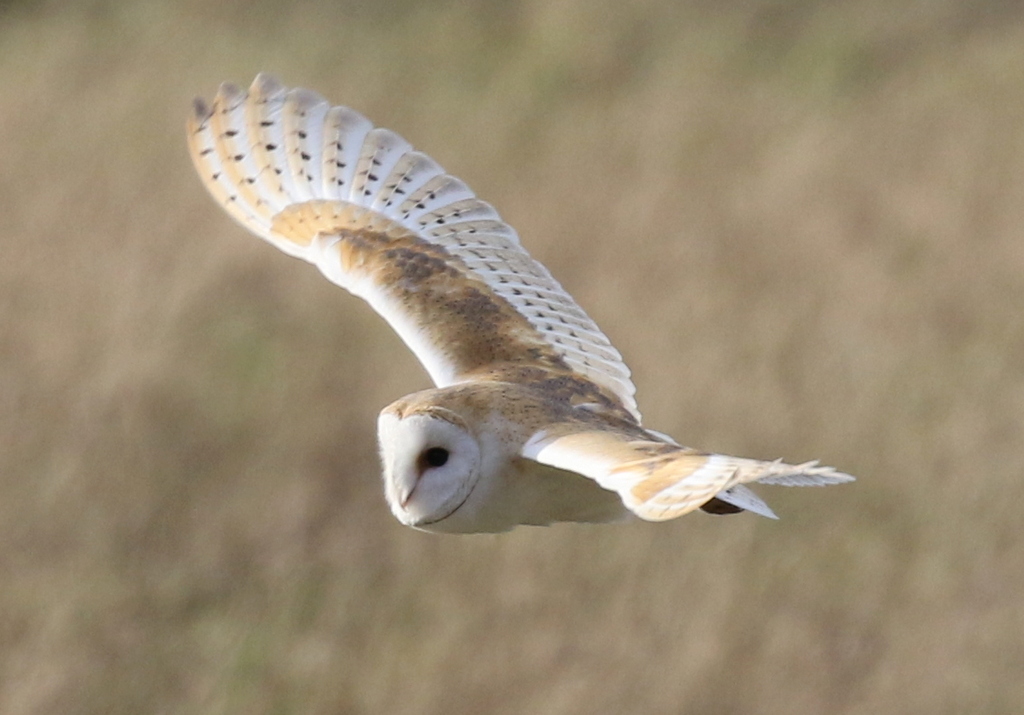
We stopped next at Lady Anne’s Drive. There is a lot of water still on the marshes here after the recent rains, and they were alive with ducks, particularly big numbers of Wigeon, which were looking very smart in the late afternoon sunshine.
Walking up towards the pines, a Grey Partridge was feeding on the grass just beyond the fence. It is quite tame, so we stopped to admire it. The larger covey which spent the winter here appears to have broken up now, with birds pairing up for the breeding season already. This male seems to be on its own. Looking over beyond The Lookout cafe as we walked towards the pines, we could see another Barn Owl in the distance, perched on a post.
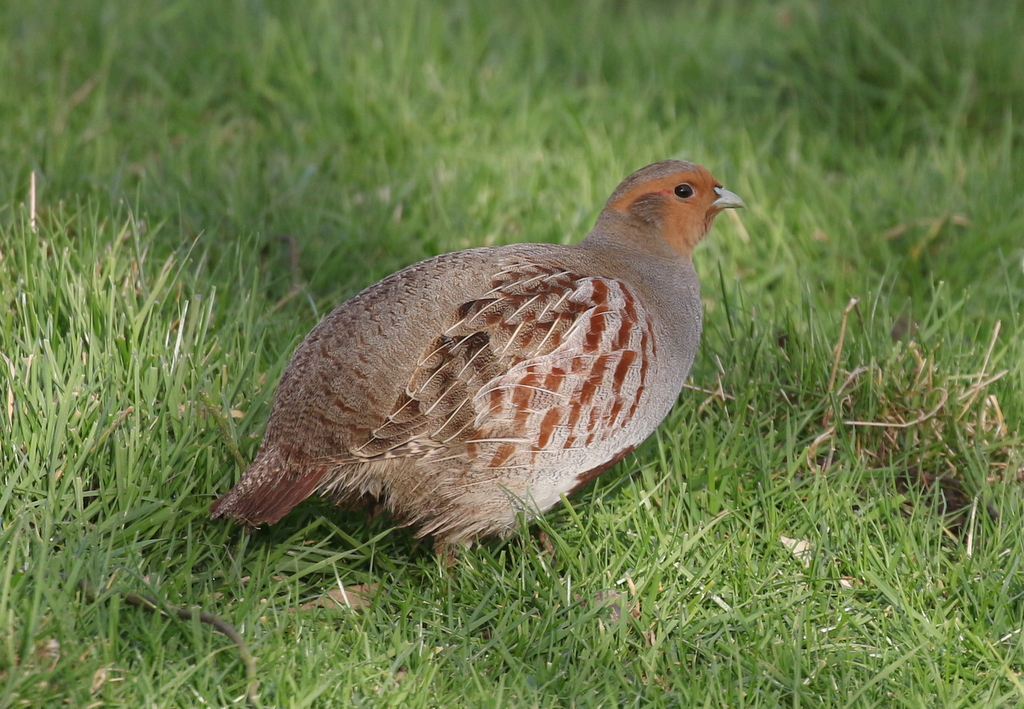
It was a big high tide this morning and the saltmarsh was under water first thing, which was why we hadn’t ventured out onto the beach here earlier today. The Shorelarks hadn’t been seen for the last few days – they always tend to get more mobile when the saltmarsh is wet – and we figured our best chance would be later in the day, to give it a chance to dry out. But there was still quite a lot of standing water on the saltmarsh when we walked out through the pines and the people we met walking back confirmed there was no sign of them again this afternoon.
There were lots of other birds feeding on the saltmarsh as we walked out towards the cordon, lots of Skylarks, several Meadow Pipits and a few Rock Pipits, and a large flock of Linnets. There were just a few more Skylarks in the cordon so with reports of some Long-tailed Ducks just offshore, we continued on out to the beach.
It didn’t take long to find the three Long-tailed Ducks, feeding in the breakers just beyond the sand bar. They were diving constantly, but in the low afternoon light we had a great look at them when they surfaced. A small group of Common Scoter were just offshore too, including several drakes and they were so close we got a good look at the yellow stripe which runs down the front of their bills. A much larger slick of Common Scoter, thousands strong, was much further out, too far for us to be able to pick anything out in with them today.
There were lots of birds on the sandbar, lots of gulls, Cormorants and Oystercatchers, and running around in and out of their legs were several small silvery-grey Sanderlings. We still hadn’t seen the Snow Buntings, and we couldn’t see any sign of them out on the beach now, so we walked a little further along and spotted them as they flew up from behind the dunes by the gap at the far end of the cordon.
The Snow Buntings landed again and we stood on the edge of the dunes and watched as they came running along the tideline towards us. We had a great look at them until they got to the end of the line of washed-up vegetation and then they were off again. They whirled round in the air and looked like they would land again a bit further back, but then turned and headed off. We counted over 50 of them as they disappeared off towards Wells.
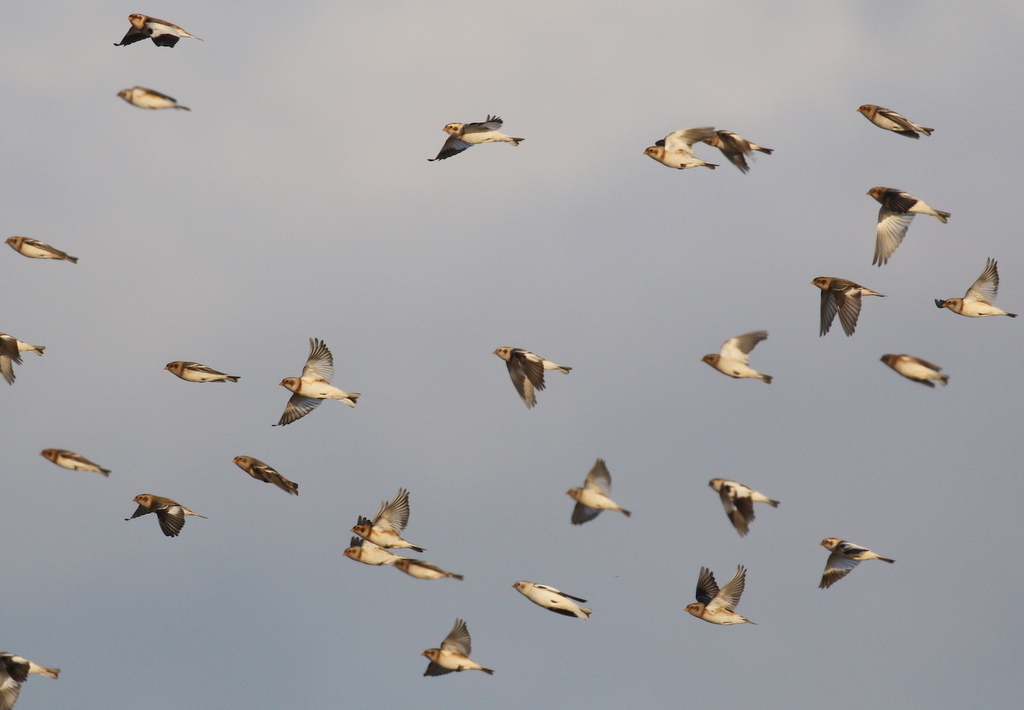
The late afternoon light was stunning now, out on the beach and it was a great view across the saltmarsh and dunes as we walked back towards the Gap. When we got back to The Lookout, we could see a couple of people looking intently out at the bank beyond and when we got so we could look down the line of the ditch, we could see a Barn Owl on a post.
We got the Barn Owl in the scope and had a look at it – and let a couple of young children who were watching it excitedly with their parents have a look through the scope too. Then it took off and flew straight towards us, landing on another post much closer still. Then yet another Barn Owl appeared on the fence further back – the wet weather last night had really brought them out in force this afternoon!

The light was starting to go now, so we made our way back to Wells. It had been a great day and we had been really lucky with the weather today.
















